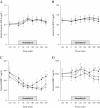Effect of hyperinsulinemia during hemodialysis on the insulin-like growth factor system and inflammatory biomarkers: a randomized open-label crossover study
- PMID: 23557110
- PMCID: PMC3637492
- DOI: 10.1186/1471-2369-14-80
Effect of hyperinsulinemia during hemodialysis on the insulin-like growth factor system and inflammatory biomarkers: a randomized open-label crossover study
Abstract
Background: A marked reduction in serum levels of bioactive insulin-like growth factor-I (IGF-I) has been observed in fasting hemodialysis (HD) patients during a 4-h HD session. The aim of the present study was to investigate the beneficial effect of hyperinsulinemia during HD on bioactive IGF-I and inflammatory biomarkers.
Methods: In a randomized cross-over study, 11 non-diabetic HD patients received a standardised HD session with either: 1) no treatment, 2) glucose infusion (10% glucose, 2.5 mL/kg/h), or 3) glucose-insulin infusion (10% glucose added 30 IU NovoRapid® per litre, 2.5 mL/kg/h). Each experiment consisted of three periods: pre-HD (-120 to 0 min), HD (0 to 240 min), and post-HD (240 to 360 min). A meal was served at baseline (-120 min); infusions were administered from baseline to 240 min. The primary outcome was change in bioactive IGF-I during the experiment. Secondary outcomes were changes in high-sensitivity C-reactive protein, interleukin-1β, interleukin-6, and tumor necrosis factor α. Comparisons were performed using mixed-model analysis of variance for repeated measures.
Results: From baseline to the end of study, no significant differences were observed in the changes in either serum bioactive IGF-I or total IGF-I between study days. Overall, serum bioactive IGF-I levels rose above baseline at 120 to 300 min with a maximum increase of 20% at 120 min (95% confidence interval (CI), 9 to 31%; p < 0.001), whereas total IGF-I levels rose above baseline at 180 to 300 min with a maximum increase of 5% at 240 min (95% CI, 2 to 9%; p = 0.004). A significant difference was observed in the changes in serum IGF-binding protein-1 (IGFBP-1) between study days (p = 0.008), but differences were only significant in the post-HD period. From baseline to the end of HD, no significant difference was observed in the changes in serum IGFBP-1 levels between study days, and in this time period overall serum IGFBP-1 levels were below baseline at all time points with a maximum decrease of 51% at 180 min (95% CI, 45 to 57%; p < 0.001). None of the investigated inflammatory biomarkers showed any differences in the changes over time between study days.
Conclusions: Postprandial insulin secretion stimulated the IGF-system during HD with no further effect of adding glucose or glucose-insulin infusion. Hyperinsulinemia during HD had no effect on biomarkers of inflammation.
Trial registration: ClinicalTrials.gov registry: NCT01209403.
Figures




References
-
- Iglesias P, Diez JJ, Fernandez-Reyes MJ, Mendez J, Bajo MA, Aguilera A, Selgas R. Growth hormone, IGF-I and its binding proteins (IGFBP-1 and −3) in adult uraemic patients undergoing peritoneal dialysis and haemodialysis. Clin Endocrinol (Oxf) 2004;60:741–749. doi: 10.1111/j.1365-2265.2004.02049.x. - DOI - PubMed
Publication types
MeSH terms
Substances
Associated data
LinkOut - more resources
Full Text Sources
Other Literature Sources
Medical
Research Materials

